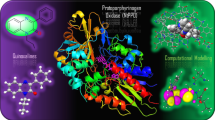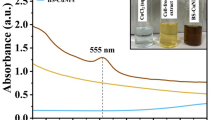Abstract
In the present work, we attempted to develop new metal complexes (Cu(II), Co(II), Ni(II) and Zn(II)) of the imine ligand which was synthesized from 9,10-phenanthrenequinone and para-anisidine. With an intention to make the complexes most stable, very special chelating amino acid has been coordinated to the metal centre. The resultant metal complexes have been characterized by variety of techniques including FT-IR, UV–Vis., 1H NMR, 13C NMR, powder XRD, EPR and mass spectral studies. The interaction of the complexes with DNA has been effectively examined and explored by fluorescence titration, UV–Vis absorption, viscometer titration, cyclic voltammetry (CV) and differential pulse voltammetry. Moreover, molecular docking analysis has been performed to understand the nature of binding of the complexes with DNA. These studies prove that CT DNA interaction of the complexes follows intercalation mode. The metal complexes exhibit effective cleavage of pUC19 DNA by an oxidative cleavage mechanism. The antimicrobial screening indicates that these complexes are good antimicrobial agents against various organisms.









Similar content being viewed by others
References
Yang W, Liu H, Du D (2010) Efficient in situ three-component formation of chiral oxazoline-Schiff base copper(II) complexes: towards combinatorial library of chiral catalysts for asymmetric Henry reaction. Org Biomol Chem 8:2956–2960
Krishnamoorthy P, Sathyadevi P, Muthiah PT, Dharmaraj N (2012) Nickel and cobalt complexes of benzoic acid (2-hydroxy-benzylidene)-hydrazide ligand: synthesis, structure and comparative in vitro evaluations of biological perspectives. RSC Adv 2:12190–12203
Lukmantara AY, Kalinowski DS, Kumar N, Richardson DR (2014) Synthesis and biological evaluation of 2-benzoylpyridine thiosemicarbazones in a dimeric system: structure-activity relationship studies on their anti-proliferative and iron chelation efficacy. J Inorg Biochem 141:43–54
Lahiri D, Majumdar R, Mallick D, Goswami TK, Dighe RR, Chakravarty AR (2011) Remarkable photocytotoxicity in hypoxic HeLa cells by a dipyridophenazine copper(II) Schiff base thiolate. J Inorg Biochem 105:1086–1094
Arjmand F, Parveen S (2012) Enantiomeric recognition of chiral L– and D–penicillamine zinc(II) complexes: DNA binding behavior and cleavage studies. RSC Adv 2:6354–6362
Antony R, Manickam STD, Kollu P, Chandrasekar PV, Karuppasamy K, Balakumar S (2014a) Highly dispersed Cu(II), Co(II) and Ni(II) catalysts covalently immobilized on imine-modified silica for cyclohexane oxidation with hydrogen peroxide. RSC Adv 4:24820–24830
Ghiaci M, Rezaei B, Arshadi M (2009) Characterization of modified carbon paste electrode by using salen Schiff base ligand immobilized on SiO2–Al2O3 as a highly sensitive sensor for anodic stripping voltammetric determination of copper(II). Sensors Actuators B 139:494–500
Mrkalić E, Zianna A, Psomas G, Gdaniec M, Czapik A, Argyropoulou EC, Kantouri ML (2014) Synthesis, characterization, thermal and DNA-binding properties of new zinc complexes with 2-hydroxyphenones. J Inorg Biochem 134:66–75
Mendu P, Kumari CG, Ragi R (2015) Synthesis, characterization, DNA binding, DNA cleavage and antimicrobial studies of Schiff base ligand and its metal complexes. J Fluoresc 25:369–378
Shamsi M, Yadav S, Arjmand F (2014) Synthesis and characterization of new transition metal {Cu(II), Ni(II) and Co(II)} L-phenylalanine-DACH conjugate complexes: in vitro DNA binding, cleavage and molecular docking studies. J Photochem Photobiol B 136:1–11
Lauria A, Bonsignore R, Terenzi A, Spinello A, Giannici F, Longo A, Almerico AM, Barone G (2014) Nickel(II), copper(II) and zinc(II) metallo-intercalators: structural details of the DNA-binding by a combined experimental and computational investigation. Dalton Trans 43:108–6119
Deschamps P, Kulkarni PP, Basak MG, Sarkar B (2005) The saga of copper(II)–L-histidine. Coord Chem Rev 249:895–909
Kawahara M, Sadakane Y, Koyama H, Konoha K, Ohkawara S (2013) D-histidine and L-histidine attenuate zinc-induced neuronal death in GT1-7 cells. Metallomics 5:453–460
Dehghan G, Dolatabadi JEN, Jouyban A, Zeynali KA, Ahmadi SM, Kashanian S (2010) Spectroscopic studies on the interaction of quercetin–terbium(III) complex with calf thymus DNA. DNA Cell Biol 30:95–201
Anbu S, Shanmugaraju S, Kandaswamy M (2012) Electrochemical, phosphate hydrolysis, DNA binding and DNA cleavage properties of new polyaza macrobicyclic dinickel(II) complexes. RSC Adv 2:5349–5357
Lerman LS (1961) Structural considerations in the interaction of DNA and acridines. J Mol Biol 3:18–14
Zheng K, Liu F, Xu XM, Li YT, Wu ZY, Yan CW (2014) Synthesis, structure and molecular docking studies of dicopper(II) complexes bridged by N-phenolato-N′-[2-(dimethylamino)ethyl]oxamide: the influence of terminal ligands on cytotoxicity and reactivity towards DNA and protein BSA. New J Chem 38:2964–2978
Ganeshpandian M, Ramakrishnan S, Palaniandavar M, Suresh E, Riyasdeen A, Akbarsha MA (2014) Mixed ligand copper(II) complexes of 2,9-dimethyl-1,10- phenanthroline: tridentate 3 N primary ligands determine DNA binding and cleavage and cytotoxicity. J Inorg Biochem 140:202–212
Antony R, Manickam STD, Karuppasamy K, Kollu P, Chandrasekar PV, Balakumar S (2014b) Organic–inorganic hybrid catalysts containing new Schiff base for environment friendly cyclohexane oxidation. RSC Adv 4:42816–42824
Barwiolek M, Szlyk E, Berg A, Wojtczak A, Muziol T, Jezierska J (2014) Structural studies of copper(II) complexes with 2-(2-aminoethyl)pyridine derived Schiff bases and application as precursors of thin organic–inorganic layers. Dalton Trans 2:9924–9933
Chew ST, Lo KM, Sinniah SK, Sim KS, Tan KW (2014) Synthesis, characterization and biological evaluation of cationic hydrazone copper complexes with diverse diimine co-ligands. RSC Adv 4:61232–61247
Kumar RS, Arunachalam S (2007) DNA binding and antimicrobial studies of some polyethyleneimine-copper(II) complex samples containg 1,10-phenanthroline and 1-theroline as co-ligands. Polyhedron 26:3255–3262
Dhanaraj CJ, Johnson J (2014) Synthesis, characterization, electrochemical and biological studies on some metal(II) Schiff base complexes containing quinoxaline moiety. Spectrochim Acta 118:624–631
Haghighi FH, Hadadzadeh H, Darabi F, Jannesari Z, Ebrahimi M, Khayamian T, Salimi M, Rudbari HA (2013) Polypyridyl Ni(II) complex, [Ni(tppz)2]2+: structure, DNA and BSA binding and molecular modeling. Polyhedron 65:16–30
Tabassum S, Zaki M, Arjmand F, Ahmad I (2012) Synthesis, characterization and interaction studies of copper based drug with human serum albumin (HSA): spectroscopic and molecular docking investigations. J Photochem Photobiol B 114:108–118
Estermann M, David W (2002) Structure determination from powder diffraction data. Oxford
Silva AR, Freitas MMA, Freire C, Castro BD, Figueiredo JL (2002) Heterogenization of a functionalized copper(II) Schiff base complex by direct immobilization onto an oxidized activated carbon. Langmuir 18:8017–8024
Bew MJ, Hathaway BJ, Fereday RJ (1972) Electronic properties and stereochemistry of the copper(II) ion. Part VII. Mono(diethylenetriamine)copper(II) complexes. Dalton Trans 12:1229–1237
Hathaway BJ, Billing DE (1970) The electronic properties and stereochemistry of mono-nuclear complexes of the copper(II) ion. Coord Chem Rev 5:143–207
Raja DS, Bhuvanesh NSP, Natarajan K (2012) A novel water soluble ligand bridged cobalt(II) coordination polymer of 2-oxo-1,2-dihydroquinoline-3-carbaldehyde (isonicotinic) hydrazone: evaluation of the DNA binding, protein interaction, radical scavenging and anticancer activity. Dalton Trans 41:4365–4377
Zhou CY, Zhao J, Wu YB, Yin CX, Pin Y (2007) Synthesis, characterization and studies on DNA-binding of a new Cu(II) complex with N1,N8-bis(l-methyl-4-nitropyrrole-2-carbonyl)triethylenetetramine. J Inorg Biochem 101:10–18
Li L, Guo Q, Dong J, Xu T, Li J (2013) DNA binding, DNA cleavage and BSA interaction of a mixed-ligand copper(II) complex with taurine Schiff base and 1,10-phenanthroline. J Photochem Photobiol B 125:56–62
Li P, Niu M, Hong M, Cheng S, Dou J (2014) Effect of structure and composition of nickel(II) complexes with salicylidene Schiff base ligands on their DNA/protein interaction and cytotoxicity. J Inorg Biochem 137:101–108
Rajarajeswari C, Loganathan R, Palaniandavar M, Suresh E, Riyasdeen A, Akbarsha MA (2013) Copper(II) complexes with 2NO and 3N donor ligands: synthesis, structures and chemical nuclease and anticancer activities. Dalton Trans 42:8347–8363
Paul A, Gupta RK, Dubey M, Sharma G, Koch B, Hundal G, Hundal MS, Pandey DS (2014) Potential apoptosis inducing agents based on a new benzimidazole schiff base ligand and its dicopper(II) complex. RSC Adv 4:41228–41236
Biver T, Secco F, Tine MR, Venturini M (2004) Kinetics and equilibria for the formation of a new DNA metalintercalator: the cyclic polyamine neotrien/copper(II) complex. J Inorg Biochem 98:33–40
Tolia GPC, Papadopoulos AN, Raptopoulou CP, Psycharis V, Garino C, Salassa L (2013) Copper(II) interacting with the non-steroidal antiinflammatory drug flufenamic acid: structure, antioxidant activity and binding to DNA and albumins. J Inorg Biochem 123:53–65
Prabahara MC, Naik HSB (2008) Binding and photocleavage of DNA by mixed ligand Co(III) and Ni(II) complexes of thiophene[2, 3-b]quinoline and phenanthrolie/bipyridine. Biometals 21:675–684
Bard AJ, Faulkner LR (1980) Electrochemical methods: fundamentals and applications. Wiley, New York
Carter MT, Bard AJ (1987) Voltammetric studies of the interaction of tris(1,10 phenanthroline) cobalt(III) with DNA. J Am Chem Soc 109:7528–7530
Blackburn GM, Gait MJ (1996) Nucleic acid in chemistry and biology. Oxford University Press, New York
Brissos RF, Torrents E, Mello FMDS, Pires WC, Lacerda EPS, Caballero AB, Caubet A, Massera C, Roubeau O, Teat SJ, Gamez P (2014) Highly cytotoxic DNA-interacting copper(II) coordination compounds. Metallomics 6:1853–1868
Tabassum S, Afzal M, Arjmand F (2014) New modulated design, docking and synthesis of carbohydrate-conjugate heterobimetallic Cu(II), Sn(II) complex as potential topoisomerase II inhibitor: in vitro DNA binding, cleavage and cytotoxicity against human cancer cell lines. Eur J Med Chem 74:694–702
Kashanian S, Ezzati J, Dolatabadi N (2009) In vitro study of calf thymus DNA interaction with butylated hydroxyanisole. DNA Cell Biol 28:535–540
Priya P, Arunachalam SV, Sathya N, Chinnusamy V, Jayabalakrishnan C (2009) Catalytic and antimicrobial studies of binuclear ruthenium(III) complexes containing bis-β-diketones. Transit Met Chem 34:437–442
Ramesh R, Maheswaran S (2003) Synthesis, spectra, dioxygen affinity and antifungal activity of Ru(III) Schiff base complexes. J Inorg Biochem 96:457–462
Lakshmipraba J, Arunachalam S, Solomon RV, Venuvanalingam P, Riyasdeenb A, Dhivyac R, Akbarshab MA (2015) Surfactant–copper(II) Schiff base complexes: synthesis, structural investigation, DNA interaction, docking studies, and cytotoxic activity. J Biomol Struct Dyn 33:877–891
Barone G, Terenzi A, Lauria A, Almerico AM, Leal JM, Busto L, García B (2013) DNA-binding of nickel(II), copper(II) and zinc(II) complexes: structure–affinity relationships. Coord Chem Rev 257:2848–2862
Tabassum S, Zaki M, Arjmand F (2013) New modulated design and synthesis of quercetin– CuII/ZnII–Sn2IV scaffold as anticancer agents: in vitro DNA binding profile, DNA cleavage pathway and -I activity. Dalton Trans 42:10029–10041
Acknowledgments
The authors express their heartfelt thanks to the College Managing Board, Principal, and Head of the Department of Chemistry, VHNSN College for providing necessary research facilities to complete this work successfully. The characterization facilities afforded by IIT Bombay and CDRI, Lucknow are gratefully acknowledged by all authors.
Author information
Authors and Affiliations
Corresponding author
Electronic supplementary material
Table S1
The spin Hamiltonian parameters of Cu(II) complex in DMSO solution at 77 K. (DOC 63 kb)
Table S2
The EPR bonding parameters of Cu(II) complex in DMSO solution. (DOC 78 kb)
Fig. S1
UV–Vis. Spectra (a) imine(−C=N) ligand, (b) [CuL(His)2], (c) [CoL(His)2] and (d) [NiL(His)2]. (DOCX 87 kb)
Fig. S2
EPR spectrum of [CuL(His)2]. (DOCX 57 kb)
Fig. S3
Mass spectra of imine(−C=N) ligand (a) and [CuL(His)2] (b). (DOCX 113 kb)
Fig. S4
Differential Pulse Voltammograms of (a) [CuL(His)2], (b) [CoL(His)2], (c) [NiL(His)2] and (d) [ZnL(His)2] in buffer (pH = 7.2) at 25 °C in presence of increasing amount of DNA. (DOCX 89 kb)
Rights and permissions
About this article
Cite this article
Arun, T.R., Subramanian, R., Packianathan, S. et al. Fluorescence Titrations of Bio-relevant Complexes with DNA: Synthesis, Structural Investigation, DNA Binding/Cleavage, Antimicrobial and Molecular Docking Studies. J Fluoresc 25, 1127–1140 (2015). https://doi.org/10.1007/s10895-015-1603-4
Received:
Accepted:
Published:
Issue Date:
DOI: https://doi.org/10.1007/s10895-015-1603-4




